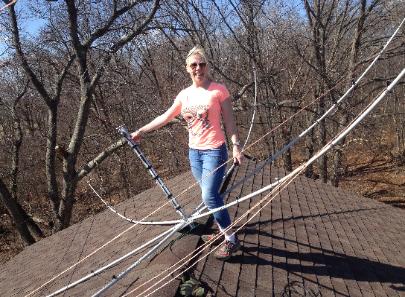Getting your KIO Hexagonal Beam up in the air
A Picture is worth a thousand words.
And here are some photos, of some of our customers’ mounting arrangements that should be helpful to you in deciding on what’s best for your own situation.
The hexagonal beam is relatively light and quite well suited for an inexpensive push up mast or a roof mounted tripod arrangement. Roof towers or push up masts can be obtained from a variety of sources on line. Just google these terms and you will easily find vendors.
Guidelines for the steel push up mast can be found here.
A decent 30 foot push up mast can be bought new for under $100. You will need to use guy ropes and probably will need help in getting the hexagonal beam mounted on the mast.
Coupling the hexagonal beam to a mast
You can see how the beam can be coupled to a push up mast or a tower mast here.
Height
Some say the ideal height for a hexagonal beam is 40 feet. Actually, there is no ideal height although 40 feet provides quite good performance for DX as well as shorter distance performance. Generally for DX, higher is better and if you can get your antenna 50 feet high, go for it. But if you can only get it up 20 feet, it is still going to perform quite well.
Flanges and adapters
If you locate the rotator at the bottom of the push up mast as many owners do and mount the hexagonal beam directly on top of the mast, this generally is a one inch (ips) fitting (1 1/4 inch O.D.) and will work with the flange that comes standard on any hexagonal beam purchased from us.
See some ideas about how to attach the beam to a mast.
The rotator can also be installed at the top of the mast but this will make guying requirements that much more important. If you do mount the rotator at the top, a short section between the rotator and the hexagonal beam (called the mast) must fit our standard one inch (ips) flange. The actual inside diameter of the standard flange is 1.315 inches. Alternatively, you can order a baseplate that is equipped with larger flange which is 1.9 inches, inside diameter. To obtain this larger flange option costs an extra $19. You can find Schedule 80 pipe made of 6061-T6 aluminum that is 1.9 inches O.D. and 0.2 inch wall thickness, a perfect fit at places like Online Metals.
Guying
Use of steel guying cable is fine but you must be concerned about resonance with the radiator wires of the hexagonal beam. You can get information in the ARRL Handbook about breaking the guy cable up into sections to avoid resonance at the different bands of your hexagonal beam. But the simplest solution is to just use non-metallic guy ropes which avoids interaction issues entirely. Such non-metallic guy ropes are available from www.radioworks.com or other ham supply houses.
Restrictions
If you are in a relatively new subdivision, you are likely to encounter legal barriers to erecting your hexagonal beam either in the form of zoning restrictions or deed covenants applicable to everyone in that neighborhood. Check this out in advance and do the necessary research
on your alternatives before buying a hexagonal beam or any supporting structure.
Rotators
Many hexagonal beam owners use a light duty rotator normally designed for TV antennas. If you are locating the rotator at the top of the mast, this light duty rotator will probably be satisfactory. But if you are rotating the push up mast as well as the antenna, such a rotator might be under a bit of strain and you might wish to consider a low end beam antenna rotator such as those offered by Yaesu, Hy Gain or others.
Safety
There is no need to duplicate the well written and thorough warnings and cautions published in several ARRL handbooks on the subject of antennas and towers. Likewise, any towers or antennas in proximity with electrical lines pose a particular hazard that must be kept in mind. There are many sad stories about such lines or towers falling or other wise coming into contact with high voltage lines with fatal results to the careless amateur. So
take heed.
 KIO Technology
KIO Technology

